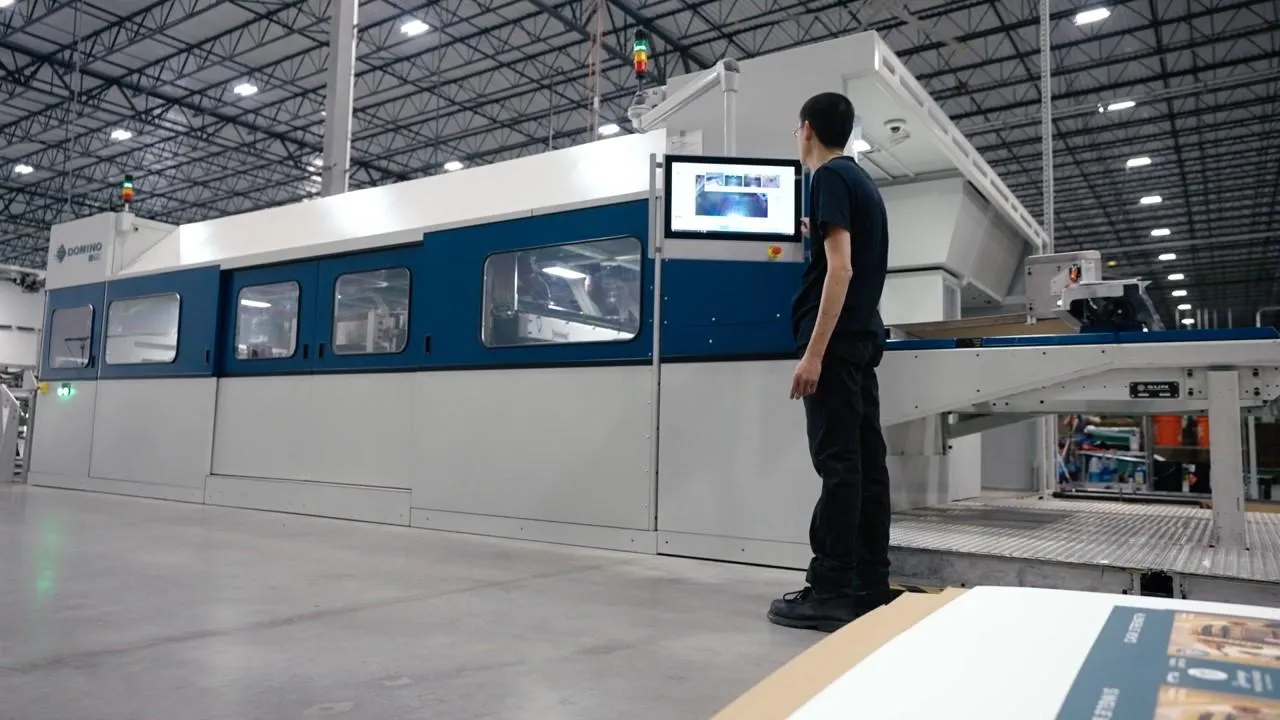In recent years, the corrugated industry has experienced a surge in demand for short and medium runs of high impact packaging, driven by growth in sectors such as the thriving craft beer market, where new product development generates a virtually constant stream of box design variations.
As converters explore the prospect of investing in digital printing equipment to keep up with demand and drive business growth, there are often misconceptions about the economics and practicalities of running a digital printing process for corrugated packaging – viewed through the lens of the conventional technologies converters are familiar with today.
Ben Ginesi, European Sales Manager – Digital Corrugated Packaging at Domino, sets out to dispel some common misconceptions about digital corrugated printing.

Myth #1: Digital is more complex than traditional printing methods
Why does that myth exist? This primarily comes from the beliefs held by converters who have experience and confidence working with traditional printing methods and processes. Flexographic printing (flexo) works well for high-volume, uncomplicated prints across a range of substrates. While lithographic printing (litho) has predominantly been used for high-quality prints with complex details. The fact that converters have printed in the same way in the corrugated industry for decades and are well versed in the process has led to the belief that the transition to digital will be difficult and burdensome – as may be expected when stepping away from the familiar and embracing a completely different process; but this is not necessarily the case.
In theory, the digital printing process is simpler and shorter than both flexo and litho: you take the digital artwork, send it to the machine, and the machine prints it – which, if everything is set up correctly, is both far easier and more efficient than a traditional process with printing plates that require time-consuming mechanical setup. But just as with any other piece of equipment, you need the right processes and people– fully-trained people – to operate it.
Myth #2: Digital printing consumables are too expensive
It is true that ink for digital presses can be more expensive than consumables for flexo or litho print, and many converters are in the mindset that the cost of ink per litre should be below a certain threshold for them to run a viable process. However, the cost of ink per litre can be a misleading indicator of the total running cost of digital printing equipment.
Ink that may seem expensive at first glance often proves better value at the bottom line, as better coverage of the substrate reduces ink consumption, lowering the cost per square metre of print. The need for primer as a consumable also feeds into the running cost, and inks that do not require pre-coating may deliver considerable savings.
Once digital press users realise this, they can move from short and medium runs to longer runs, which increases the use of the press, and further enhances return on investment.
Myth #3: Digital presses have a large footprint and require a specialised space
Corrugate converters researching digital printing presses are often concerned about the size of the equipment and wonder if they have the space and resources to be able to create an environment in which to run a corrugated printing press.
Some digital corrugated presses have a larger footprint than their flexographic counterparts, and building a cleanroom to create the controlled environment needed to accommodate a digital press can take up a lot of additional space and investment. However, there are corrugated digital inkjet presses on the market that use fast-drying inks that only require compact drying modules, greatly reducing the overall footprint. In addition, some presses also feature internal environmental controls for temperature and dust extraction, eliminating the need for a cleanroom – which means you can effectively place the press alongside the traditional presses in your facility.
Myth #4: Finding a digital press operator is difficult
In recent years, the skills and knowledge gap in the print industry – widening as experienced professionals are retiring – has often been named as one of the key challenges for converters. Viewed from this perspective, recruiting a press operator may seem daunting.
However, once converters realise a digital press operator requires a completely different set of skills than a traditional printing professional, finding the right person becomes a lot easier. The fact that no technical know-how specific to the printing industry is required to run a digital press means that converters benefit from access to a much wider pool of potential candidates than they would have when recruiting for a flexo press operator.
An operator with decades of experience in running a flexo or litho printing press, with all the mechanical set-up that is required, will likely need time and specific training to adapt to the digital process – as would be expected from someone who has spent years doing things in a certain way. The general ease of using a digital press, however, will soon make controlling, setting up, and optimising the digital printing process via a touchscreen interface second nature.
Given the predominance of digital devices in everyday life, even someone without prior experience in the printing industry might have an easy time adapting to operating a digital press.
Myth #5: The ROI for any digital printing process is the same
While the general benefits of digital printing versus traditional printing methods are well known and apply to any digital printing process – more flexibility for shorter runs of variable designs and faster turnaround – the same cannot be said for the return on investment (ROI). Converters should pay particular attention to the total cost of ownership, as running costs can vary greatly across equipment available in the market.
There’s a connection between how effectively the digital and mechanical elements of a press work together that translates across to the ROI. And, ultimately, that’s what a lot of people don’t realise. It’s not a one size fits all approach across brands and digital press models.
Digital presses combine various, often proprietary, technologies that all factor into the ROI. How much – or how little – of a contribution they make can vary greatly: some fast-drying ink formulations proactively contribute to lower energy consumption thanks to reduced drying time; printheads and ink sets that provide excellent coverage in a single pass can reduce overall ink consumption, reducing the cost per printed board; environmental controls on-board a press eliminate the need – and cost – for maintaining a controlled environment in a larger space, such as a custom-built cleanroom – never mind the cost of installing the cleanroom in the first place.

Conclusion
There are many misconceptions when it comes to investing in digital corrugated printing equipment, and converters are often surprised when they discover the reality of running a digital printing process – from staffing and consumables to the all-important return on investment.
Converters should look beyond the myths and partner with a trusted digital printing provider for a genuine appraisal of the ROI for their corrugated print application; a strong partner who will support them as they are taking the first steps into the digital printing landscape – from providing valuable insights into the ideal profile a digital press operator should have, to identifying profitable business opportunities and new applications.